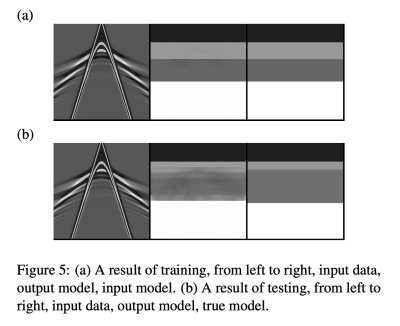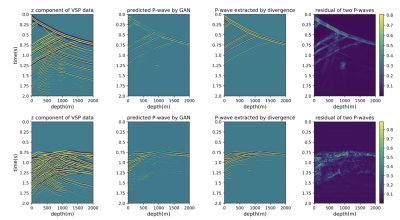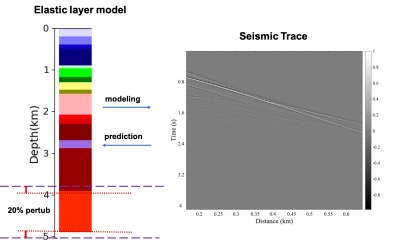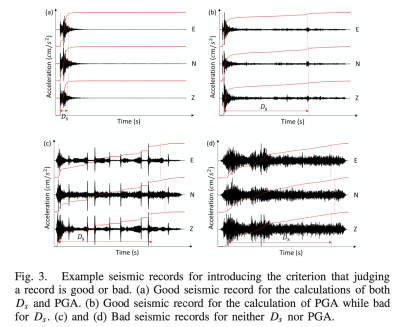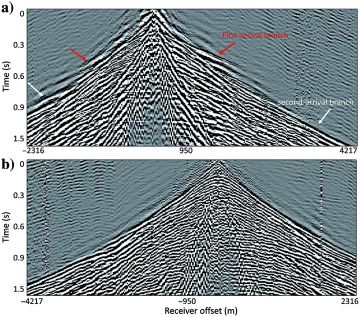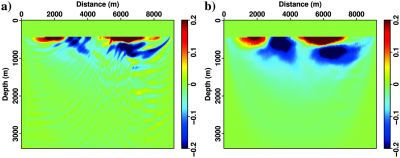Geophysics
The geophysics group currently has four members, including 1 postdoc, Mengyao Sun and 3 Phd students, Yanwen Wei, Cewen Liu and Wei Wu. We have a wide interest in seismic forward modeling, active-source inversion (i.e., full waveform inversion, reverse time migration) and passive-source method. Recent contributions are integrating the high-tech in the field of high performance computing and artificial intelligence.
Machine learning applications in Geophysics
P/S wave separation - multi-task FCN
Wei, Y., Li, Y. E., Yang, J., Zong, J., Fang, J., & Fu, H. (2020). Multi-task learning based P/S wave separation and reverse time migration for VSP. In SEG Technical Program Expanded Abstracts 2020 (pp. 1671-1675). Society of Exploration Geophysicists. doi
P/S wave mode separation is an essential tool for single-mode analysis from multi-component seismic data. Wave separation methods in recorded data require expert knowledge to choose parameters in different shots of data. To make this process automatic, we propose a machine learning-based method to separate P/S waves. This method employs a multi-task neural network that extracts P- and S-potential simultaneously from multi-component VSP data. Targeting at a specific testing dataset, we derive an efficient building strategy to construct training datasets. Synthetic data experiment shows NN trained on our training dataset performs well both in training and testing datasets. We also make further verifications from the view of acoustic reverse time migration. The separated waves by using NN trained on our training datasets have a considerable high-resolution PP and PS imaging.
PSF resolution enhancement - Net
Liu, C., Dai, N., Sun, M., Wu, W., & Fu, H. (2020, December). Enhancing the Resolution of Seismic Imaging by Deconvolving Point Spread Function. In 82nd EAGE Annual Conference & Exhibition (Vol. 2020, No. 1, pp. 1-5). European Association of Geoscientists & Engineers. doi
Migration image deblurring is an important post-processing procedure for generating a high-resolution geological section. However, traditional methods for deblurring migration images usually require high computational cost, and the improvement is limited. In order to reduce the high computational cost and gain a high-resolution migration image at the same time, we propose a point spread function (PSF) deconvolution method. The PSFs are obtained via some selected scattered-points on a pre-prepared reflectivity model whose size is the same as the blurred migration image, then the deconvolution operator for each point can be acquired according to its PSF. Deconvolution operators for the rest of the points that are not selected are obtained by interpolation according to those selected ones. We then apply all deconvolution operators to the blurred migration image so that the resolution could be improved. Results from synthetics and the field data application reveal that the spatial resolution of the migration image is improved significantly with lower computational cost and storage demand, which suggests that the proposed approach is promising in practical applications.
velocity model building - GAN
Wei, Y., Sun, M., & Fu, H. (2018, December). Training an Inverse Operator on Shingling Seismic Data based on cGANs. In SEG 2018 Workshop: SEG Maximizing Asset Value Through Artificial Intelligence and Machine Learning, Beijing, China, 17-19 September 2018 (pp. 1-4). Society of Exploration Geophysicists and the Chinese Geophysical Society. doi
We focus on a specific inverse problem, which is to work out the near-surface velocity model from shingling data that may be caused by reversed velocity sequences. The traditional inversion method first arrival traveltime tomography cannot handle such type of seismic data. A conditional generative adversarial network has the similar goal with an inverse problem. That is to generate model from given data, trying not to be distinguished from the true model given in training process. The network learns the relationship between data and model, especially the direction from data to model, and it can be seen as an inverse operator. We rebuild our network based on a well used general image-to-image cGANs framework, and create our datasets of shingling data through wave-equation based finite difference simulation method. After training 2D synthetic pairs of shingling seismic data and velocity model, we acquire a 100% accuracy in training datasets, and 62% in a test dataset which is completely different from the training datasets. Additionally, the proposed method presents a high resolution of the prediction model.
P-wave reconstruction - GAN
Wei, Y., Fu, H., Li, Y. E., & Yang, J. (2019). A new P-wave reconstruction method for VSP data using conditional generative adversarial network. In SEG Technical Program Expanded Abstracts 2019 (pp. 2528-2532). Society of Exploration Geophysicists. doi
Wave-mode separation is an essential step of multicomponent seismic data processing. Due to limited acquisition at sparse receiver locations, conventional physics-based wavemode decomposition methods are only feasible based on many strong assumptions such as homogeneous subsurface velocity and flat structures. We propose a new P-wave reconstruction method based on VSP data, aiming to learn the domain transformation directly from full waveform elastic VSP data to their P-wave components. This method is based on optimal transportation theory and implemented by Generative Adversarial Network. We train network on 22180 pairs of synthetic data produced on 2D subsurface model and test on 40596 pairs. The network outputs achieve an average accuracy rate of 97.87%. The results tested on the 2D synthetic data show the network is capable of learning the waveform of target separated data beyond phase recognition and wave classification.
1.5D inversion - ResNet
Liu, C., Sun, M., Dai, N., Wu, W., & Fu, H. (2020, November). Inverting Elastic Model Properties Using ResNet. In First EAGE Digitalization Conference and Exhibition (Vol. 2020, No. 1, pp. 1-5). European Association of Geoscientists & Engineers. doi
We develop a novel seismic data inversion method to estimate the properties of subsurface layered elastic models using Convolutional Neural Network (CNN). Specially, we use ResNet (Residual Neural Network) to predict the parameters of layered elastic models, including layer depth, layer density, P-wave, and S-wave velocities for its unique identity block architecture. The entire dataset consists of 10,000 layered elastic models and their corresponding single shot records. We use 80% pairs from the dataset to implement the training process, and then the trained network could make predictions on the rest of the models in the dataset. Our trained network presents satisfying prediction results on both simple (i.e., few-layer) and complex (i.e., multi-layer) models, and it suggests that the proposed approach could be a useful tool for data processing, especially when dealing with near-surface layered models.
seismogram discriminator - ResNet
Zhu, H., Sun, M., Fu, H., Du, N., & Zhang, J. (2020). Training a Seismogram Discriminator Based on ResNet. IEEE Transactions on Geoscience and Remote Sensing. doi
Selecting appropriate data of good quality is the primary precondition for conducting meaningful analysis in seismological research. The data set used in a study is usually selected by setting a threshold for searching the earthquake catalog to ensure data quality, such as parameters of magnitude or hypocentral distance. While the threshold approach is useful, it cannot guarantee the consistently good quality of the selected seismograms. For that reason, a manual checking process is often required for quality control, which is inefficient and fallible for large data sets. In this study, we develop an automated seismogram discriminator that is capable of selecting quality seismograms from massive events. The discriminator is created based on a machine learning technique using a residual neural network (ResNet), a well-designed architecture in computer image recognition. Three-component seismic records of an earthquake from the catalog are considered as images by the ResNet. Using the images of seismic records, the ResNet can be trained to distinguish between good and poor seismic records. This discriminatory ability is evaluated using a blind testing data set of approximately 20,000 three-component seismic records related to the events that occurred in Sichuan between January 2014 and May 2018. The results show that our seismogram discriminator achieves an accuracy of greater than 95%.
ground motion analysis
Sun, M., Zhu, H., Zhang, J., Fu, H., & Tian, X. (2019). Ground Motion from Mw 1.5 to 3.9 Aftershocks of the 2014 Mw 6.2 Jinggu Earthquake at Hypocentral Distances< 45 km in Yunnan, China. Seismological Research Letters, 90(5), 1876-1888.
doi
The ground motion from small aftershocks of the 2014 Mw 6.2 Jinggu earthquake in Yunnan Province is analyzed. With the seismic records, we assess the site conditions and develop a ground‐motion prediction equation (GMPE) for this region. The strong‐motion duration is also calculated to further understand the potential seismic hazard to nearby structures. The dataset includes 504 events with Mw 1.5–3.9 and 2956 three‐component records at hypocentral distances <45km from 10 stations operated by the Earthquake Administration of Yunnan Province. The ground‐motion amplification factor derived from the horizontal‐to‐vertical (H/V) spectral ratio of each station ranges from 1.1 to 5.2 (0.04–0.72 in log units). The time‐averaged shear‐wave velocity to 30 m depth (VS30) for seismographic stations is estimated using fundamental frequencies associated with peak H/V ratios. GMPE is obtained using the entire dataset. The values of the geometrical spreading coefficient for the pseudoabsolute response spectral acceleration (PSA) at a frequency of 10 Hz suggest higher decay than those for the peak ground velocity, peak ground acceleration (PGA), and PSA at other frequencies. The significant duration (Ds) of strong ground motion systematically decreases with PGA but increases with hypocentral distance. However, no strong correlation is observed for Ds and magnitude or for Ds and VS30. The results of this study are compared with analogous research (Babaie Mahani and Kao, 2018) on induced earthquakes with the same distance–magnitude range. The comparison indicates that the decay of ground‐motion amplitudes with hypocentral distance in our case is generally lower than that in the other study. The Ds trends are consistent in the two studies, although the longest strong‐motion duration in the two cases apparently differs.
ground motion simulation - Wenchuan
Chen, B., Fu, H., Wei, Y., He, C., Zhang, W., Li, Y., ... & Yang, G. (2018, November). Simulating the Wenchuan earthquake with accurate surface topography on Sunway TaihuLight. In SC18: International Conference for High Performance Computing, Networking, Storage and Analysis (pp. 517-528). IEEE. doi
This paper reports our efforts on performing a 50-m resolution earthquake simulation of the Wenchuan Earthquake (Ms 8.0, China) on Sunway TaihuLight. To accurately capture the surface topography, we adopt a curvilinear grid finite-difference method with a traction image free surface implementation and redesign the algorithm to reduce memory access costs for heterogeneous many-core architectures. We then derive a performance model of our algorithm to guide and drive the further optimization and tuning of various parameters using a genetic algorithm. A data layout transformation is also proposed to improve the direct memory access (DMA) efficiency further. Our efforts improve the simulation efficiency from 0.05% to 7.6%, with a sustained performance of 9.07 Pflops using the entire machine of the Sunway TaihuLight (over 10 million cores), and a large-scale simulation of the Wenchuan earthquake with accurate surface topography and improved coda wave effects.
ground motion simulation - Tangshan
Fu, H., He, C., Chen, B., Yin, Z., Zhang, Z., Zhang, W., ... & Yang, G. (2017, November). 9-Pflops nonlinear earthquake simulation on Sunway TaihuLight: enabling depiction of 18-Hz and 8-meter scenarios. In Proceedings of the International Conference for High Performance Computing, Networking, Storage and Analysis (pp. 1-12). doi
This paper reports our large-scale nonlinear earthquake simulation software on Sunway TaihuLight. Our innovations include: (1) a customized parallelization scheme that employs the 10 million cores efficiently at both the process and the thread levels; (2) an elaborate memory scheme that integrates on-chip halo exchange through register communcation, optimized blocking configuration guided by an analytic model, and coalesced DMA access with array fusion; (3) on-the-fly compression that doubles the maximum problem size and further improves the performance by 24%. With these innovations to remove the memory constraints of Sunway TaihuLight, our software achieves over 15% of the system's peak, better than the 11.8% efficiency achieved by a similar software running on Titan, whose byte to flop ratio is 5 times better than TaihuLight. The extreme cases demonstrate a sustained performance of over 18.9 Pflops, enabling the simulation of Tangshan earthquake as an 18-Hz scenario with an 8-meter resolution.
near-surface velocity reversal
Sun, M., & Zhang, J. (2020). The near-surface velocity reversal and its detection via unsupervised machine learning. Geophysics, 85(3), U55-U63. doi
In land seismic data processing, picking the first arrivals and imaging the near-surface velocity structures are important tasks. However, in many areas, the near-surface weathering layer includes high-velocity reversals, causing the first arrivals to exhibit shingling effects, which are difficult for picking at the far offset. We have used an acoustic full-waveform modeling method in a multilayered half-space to simulate first arrivals with the velocity reversal. Numerical tests indicate that under certain conditions, shingling occurs if the seismic wave propagates through a thin velocity reversal layer embedded in the shallow structures. Detection of shingling is essential for the selection of valid near-surface imaging solutions, such as first-arrival refraction, or waveform solutions for the appropriate areas. We find that an automated detection scheme that uses unsupervised machine learning can help identify the velocity reversal. We test the method on synthetic and real data, and the testing shows that the automated detection result matches our visual judgment well. After the automated detection, appropriate inversion approaches can be applied to corresponding areas.
random space shift FWI
Yang, J., Li, Y. E., Liu, Y., Wei, Y., & Fu, H. (2020). Mitigating the cycle-skipping of full-waveform inversion by random gradient sampling. Geophysics, 85(6), R493-R507. doi
Full-waveform inversion (FWI) is a highly nonlinear and nonconvex problem. To mitigate the dependence of FWI on the quality of starting model and on the low frequencies in the data, we apply the gradient sampling algorithm (GSA) introduced for nonsmooth, nonconvex optimization problems to FWI. The search space is hugely expanded to have more freedom to accommodate large velocity errors in the starting model. The original implementation of GSA requires explicit calculation of the gradient at each sampled vector, which is prohibitively expensive. Based on the observation that a slight perturbation in the velocity model causes a small spatial shift of the wavefield, we have approximated the sampled gradients by crosscorrelating the space-shifted source- and receiver-side wavefields. Theoretical derivation suggests that the two wavefields should be shifted in the same direction to obtain reasonable low-wavenumber updates. The final descent search direction is obtained by summing all the shifted gradients. For practical implementation, we only take one random space shift at each time step during the gradient calculation. This simplification provides an efficient realization in which the computational costs and memory requirements are the same as conventional FWI. Multiple numerical examples demonstrate that the proposed method alleviates the cycle-skipping problem of conventional FWI when starting from very crude initial velocity models without low-frequency data.






